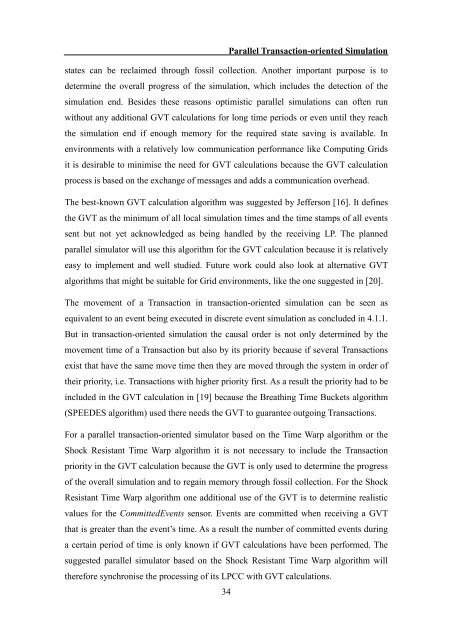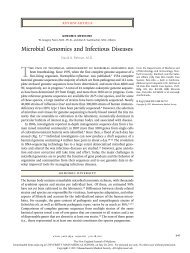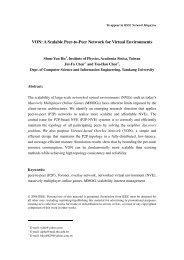3.1 MB - Evernote
3.1 MB - Evernote
3.1 MB - Evernote
Create successful ePaper yourself
Turn your PDF publications into a flip-book with our unique Google optimized e-Paper software.
34<br />
Parallel Transaction-oriented Simulation<br />
states can be reclaimed through fossil collection. Another important purpose is to<br />
determine the overall progress of the simulation, which includes the detection of the<br />
simulation end. Besides these reasons optimistic parallel simulations can often run<br />
without any additional GVT calculations for long time periods or even until they reach<br />
the simulation end if enough memory for the required state saving is available. In<br />
environments with a relatively low communication performance like Computing Grids<br />
it is desirable to minimise the need for GVT calculations because the GVT calculation<br />
process is based on the exchange of messages and adds a communication overhead.<br />
The best-known GVT calculation algorithm was suggested by Jefferson [16]. It defines<br />
the GVT as the minimum of all local simulation times and the time stamps of all events<br />
sent but not yet acknowledged as being handled by the receiving LP. The planned<br />
parallel simulator will use this algorithm for the GVT calculation because it is relatively<br />
easy to implement and well studied. Future work could also look at alternative GVT<br />
algorithms that might be suitable for Grid environments, like the one suggested in [20].<br />
The movement of a Transaction in transaction-oriented simulation can be seen as<br />
equivalent to an event being executed in discrete event simulation as concluded in 4.1.1.<br />
But in transaction-oriented simulation the causal order is not only determined by the<br />
movement time of a Transaction but also by its priority because if several Transactions<br />
exist that have the same move time then they are moved through the system in order of<br />
their priority, i.e. Transactions with higher priority first. As a result the priority had to be<br />
included in the GVT calculation in [19] because the Breathing Time Buckets algorithm<br />
(SPEEDES algorithm) used there needs the GVT to guarantee outgoing Transactions.<br />
For a parallel transaction-oriented simulator based on the Time Warp algorithm or the<br />
Shock Resistant Time Warp algorithm it is not necessary to include the Transaction<br />
priority in the GVT calculation because the GVT is only used to determine the progress<br />
of the overall simulation and to regain memory through fossil collection. For the Shock<br />
Resistant Time Warp algorithm one additional use of the GVT is to determine realistic<br />
values for the CommittedEvents sensor. Events are committed when receiving a GVT<br />
that is greater than the event’s time. As a result the number of committed events during<br />
a certain period of time is only known if GVT calculations have been performed. The<br />
suggested parallel simulator based on the Shock Resistant Time Warp algorithm will<br />
therefore synchronise the processing of its LPCC with GVT calculations.
















